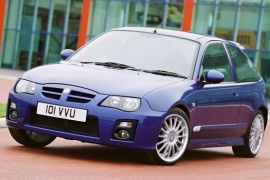
MG ZR 3 Doors
Generations Timeline, Specs and Pictures

The MG ZR was a compact vehicle introduced in 2001 by the MG Rover Group.
The hot-hatch was actually a badge-engineered Rover 25 that suffered few changes such as an improved suspension and a more attractive exterior and interior design.
The attractive ZR was built in 3- and 5-door body styles, available with a variety of engines and trim levels.
In 2004, MG decided to update the small sporty car along with the rest of the vehicles in the range.
With the new exterior design changes, the ZR was no longer that similar to the Rover 25.
Inside, the revised interior design was more appealing than before. The new dash design incorporated the climate controls on some models and the cloth upholstery was refreshed.
Other updates included a sunroof, 16-inch Grid Spoke alloys, refreshed rear light clusters, a leather steering wheel, side sills and rear bumper extensions.
Aside from the mentioned improvements, the ZR remained the same agile, aggressive looking pocket-rocket with a precise steering and great stability in turns.
The facelifted ZR should have been given an award for the shortest life in the automotive history, as its production ceased on its 1 year birthday.
The MG Rover Group went bankrupt in April 2005, just when the carmaker was about to release a new model to replace the ZR.

MG started back in the ’20s as a tuner for the British brand Morris (MG stands for Morris Garage).
Its original utility on the market was kept and in 2001, the MG showed the sportiest version of the Rover 25. It installed the 1.8-liter K-series engine produced by MG and exploit its potential in the small Rover 25, than rebadge-it and named it MG ZR.
The small hot-hatch featured a 160 hp gasoline engine under the hood and the only transmission available was a 5-speed gearbox. The suspension was stiffened and a new sport interior was installed. In the end, the overall look was a pocket-rocket.
The white background for the dials in the instrument cluster was something that not many car manufacturers dared to do. The bolstered seats were good in supporting the driver and its side passenger in place when hard cornering. The rear seats were designed for two seats only, but under the nice upholstery, it was just the same bench-seat from the Rover 25. The pedals were aluminum in a racing spirit.
On the outside, the 17” light-alloy wheels stood out of the crowd. A rear roof spoiler and a bigger front bumper were included in the aerodynamic package. So, the final look was aggressive and the performance was good for a hot-hatch from that time. But it didn’t last long.























































